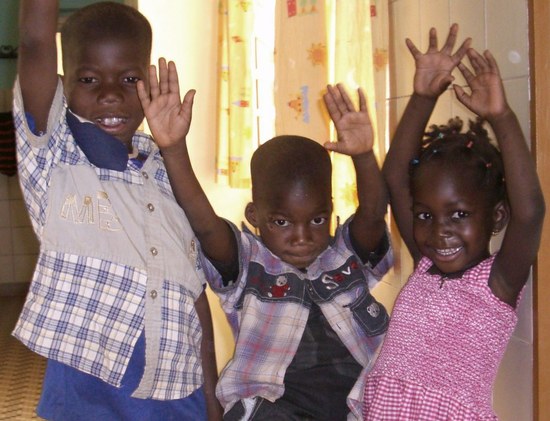 Do not be scared if the following report smells “science”. The project we present is an excellent example of how a clinical problem typical for resource poor countries identified by one member of the MMI Network could be brought to the attention of another member with the necessary expertise and resources to allow for specific analysis in yet another resource poor country and, most important, implementing the results to the benefit of the patients in need. We hope that this fruitful cooperation among Medicus Mundi members from different countries and involving a research institution from the “South” can serve as an example for many other clinical problems that still await their solution!
Do not be scared if the following report smells “science”. The project we present is an excellent example of how a clinical problem typical for resource poor countries identified by one member of the MMI Network could be brought to the attention of another member with the necessary expertise and resources to allow for specific analysis in yet another resource poor country and, most important, implementing the results to the benefit of the patients in need. We hope that this fruitful cooperation among Medicus Mundi members from different countries and involving a research institution from the “South” can serve as an example for many other clinical problems that still await their solution!
Development and implementation of paediatric HIV/AIDS treatment remains a priority, especially in low-income countries where most of HIV infected children live and where the lowest percentage of them is actually on highly active antiretroviral (ARV) therapy1.
According to the current WHO algorithm for the management of HIV/AIDS in children, treatment should start as early as possible in all infected children below 24 months of age without considering a specific CD4+ threshold2. Furthermore, an effective ARV regimen should comprise of three drugs representing at least two different classes. Up to this date only four quality assured triple-drug fixed-dose combinations (FDC) are available in solid and dispersible forms3. In most countries – among them Burkina Faso – only one is available and this combination is based on the three molecules Lamivudine (3TC), Nevirapine (NVP) and Stavudine (d4T) – the latter being currently discontinued due to severe side-effects. In addition, dosing of two of those molecules (3TC and d4T) is based on body weight while the third is ideally dosed per body surface area.
By definition, a fixed-dose combination cannot satisfy this important requirement exactly, as weight and surface area do not increase in parallel. Another limitation of the available FDCs is due to the fact that they come as scored tablets, thus allowing only approximate dosing by rounding to the nearest half tablet. As explained in Table 1, which is based on the current dosing recommendations for FDC based on weight bands, this leads to significant over- or underdosing. Thus, in order to achieve correct doses, actually the only possibility is to use three different liquid formulations, each containing only one active ingredient. Given the fact that the medicines need to be taken twice daily, the care giver every day needs to measure and administer six times different volumes, which can be quite a challenge in the real setting, where the child is crying and the care giver wishes to conceal the HIV status to other members of the household.
| weight (kg) | Number of tablets | daily dose using FDC (mg/kg/day) | ideal daily dose (mg/kg/day) | % of correct d4T dose |
% of correct 3TC dose |
|||
|
6 |
30 |
50 |
2 |
8 |
||||
|
d4T |
3TC |
NVP |
d4T |
3TC |
||||
|
3 |
2 |
12 |
60 |
100 |
6 |
24 |
200,0 |
250,0 |
|
4 |
2 |
12 |
60 |
100 |
8 |
32 |
150,0 |
187,5 |
|
5 |
2 |
12 |
60 |
100 |
10 |
40 |
120,0 |
150,0 |
|
6 |
3 |
18 |
90 |
150 |
12 |
48 |
150,0 |
187,5 |
|
7 |
3 |
18 |
90 |
150 |
14 |
56 |
128,6 |
160,7 |
|
8 |
3 |
18 |
90 |
150 |
16 |
64 |
112,5 |
140,6 |
|
9 |
3 |
18 |
90 |
150 |
18 |
72 |
100,0 |
125,0 |
|
10 |
4 |
24 |
120 |
200 |
20 |
80 |
120,0 |
150,0 |
|
11 |
4 |
24 |
120 |
200 |
22 |
88 |
109,1 |
136,4 |
|
12 |
4 |
24 |
120 |
200 |
24 |
96 |
100,0 |
125,0 |
|
13 |
4 |
24 |
120 |
200 |
26 |
104 |
92,3 |
115,4 |
|
14 |
5 |
30 |
150 |
250 |
28 |
112 |
107,1 |
133,9 |
|
15 |
5 |
30 |
150 |
250 |
30 |
120 |
100,0 |
125,0 |
Table 1: dosing recommendations for paediatric ARVs
Furthermore, dosing of each of the three liquid formulations needs to be adjusted individually to the child’s weight and body surface on a monthly basis, making the caregivers job even more difficult, not to mention that most of those liquid formulations need to be stored below 12° or even 8° Celsius – a condition that can’t be reached in most of the poor households where the only “refrigeration” is a clay pot filled with water, capable of maintaining a temperature of 25°C! Usually children start to swallow tablets more easily once they reach a body weight of 15 kg.
From the financial point of view, all paediatric formulations and especially the liquid formulations have a much higher cost than the adult formulations.
In order to tackle this whole set of problems, we wanted to explore the possibility of preparing for each patient below 15 kg an individualized liquid formulation, containing all three active ingredients, each at the individual correct dose – thus allowing for a range of ratios between the ingredients dosed on body weight and those dosed per body surface area (Abacavir/Nevirapine ratio between 0.9 and 1.2). The concentration of the active ingredients should increase over time, allowing maintaining the same volume to be measured and administered for a time span of several months and a storage temperature for the solution at 30°C for 30 days. Cheap and available adult formulations were to be used as starting material. d4T was substituted by Abacavir (ABC) as the former will be phased out and is no more available in adult formulations in Burkina Faso. Finally the compounding procedure should be simple and robust allowing the manufacture of individualized paediatric formulations at hospital level.
A joint study of Medicus Mundi Italy and action medeor was undertaken at the Pharm R&D Laboratory of the Muhimbili University of Health and Allied Sciences (MUHAS) in Dar es Salaam, in which the challenges of the Lamivudine/Abacavir/Nevirapine (LAN) suspension were scientifically reviewed and a feasible way for preparation of a stable individualized triple combination suspension was proposed. The process was started by developing an analytical method to detect and quantify all three active ingredients simultaneously; the selected method was then validated. Using adult mono ARV tablets and sorbitol 70% as a diluent, three combination suspensions for children of different weight and body surface area were prepared – by pulverizing the respective number of tablets and moistening with appropriate amount of water, triturating gently while adding the diluent to form a smooth paste – and then transferred into a graduated bottle to make up the volume to 300 ml (PET bottles) with the diluent. The stability study was conducted for 42 days at controlled tropical storage conditions (30 °C / 75% RH). The sampling was done at days 0, 5, 14, 28 and 42. The testing covered appearance, odour, pH, resuspensibility and content of active ingredients.
We found that the appearance and odour of all of the three tested formulations did not change over the total test period and there was no significant change of pH, which indicated the absence of hydrolysis. Furthermore, no problems were observed concerning the resuspensibility of the stored formulations, and the content of the active ingredients did not change significantly within the test period (figure 1) Occurring variation of the single results of the assay of the active ingredients can be explained by inaccuracies during the dosing procedure, no trend of change of the content of the active ingredients in one direction could be observed. The range of the obtained single content results of the active ingredients were 92 – 103 % for Lamivudine, 96 – 103 % for Abacavir and 92 -104 % for Nevirapine. Assuming that with respect to the normal biological variation a minimum content of 90 % of the claim can generally be accepted and that toxic degradation has not to be expected, the tested standard formulations can be regarded as stable under in-use conditions for 6 weeks.
| Day 0 | Day 42 | |||||
| Formulation(%) |
1 |
2 |
3 |
1 |
2 |
3 |
| Lamivudine (%) |
93.5 |
92.2 |
100.6 |
92.6 |
92.3 |
96.9 |
| Abacavir (%) |
96.3 |
103.2 |
100.1 |
98.4 |
95.7 |
97.7 |
| Nevirapine (%) |
100.4 |
101.8 |
102.6 |
94.5 |
104.5 |
94.4 |
Table 2: Content of Lamivudine, Abacavir and Nevirapine (LAN) on day 0 and 42.
Figure 1: Content of Lamivudine, Abacavir and Nevirapine (LAN) on day 0 and 42.
The results will help hospitals to compound individual LAN liquid formulations for children of 3 – 15 kg, hence reducing the total number of administrations to twice per day and the number of bottles of the formulation for a child to one per month. The volume administered can remain stable as the concentration will be increased over the time as prescribed. This will enhance the adherence by decreasing the complexity for the care givers and the discomfort of the paediatric patients.
A decentralized preparation of the individualized combination suspensions in a hospital setting seems feasible because little material and technical equipment is needed. On the other hand, well-trained and cautious pharmacy staff is required to avoid dosing mistakes. A pilot study on implementation of this formulation is currently under way in a controlled setting in Burkina Faso.
Notes
(1) Pediatric HIV — A Neglected Disease? Lallemant M., Chang S, Cohen R., Pecoul B.,
NEJM 365;7:581-3.
(2) Antiretroviral therapy of HIV infection in infants and children: towards universal access: recommendations for a public health approach – 2010 revision. Geneva: World Health Organization, 2010.
(3) Improving treatment outcome for children with HIV. Calmy AL., Ford N.
The Lancet 377:1546-8
Authors: P. Tibalinda and E. Kaale, Pharm R&D Laboratory, Muhimbili University of Health and Allied Sciences; C. Haefele-Abah, action medeor; R.F. Schumacher, Medicus Mundi Italia and Department of Paediatrics, Spedali Civili, Brescia. This project was funded by a grant from the Istituto Superiore di Sanità of the Italian Health Ministry under the “Ensemble pour une solidarité thérapeutique hospitaliere en Reseau contre le SIDA “ (ESTHER) Program to the University of Brescia.



